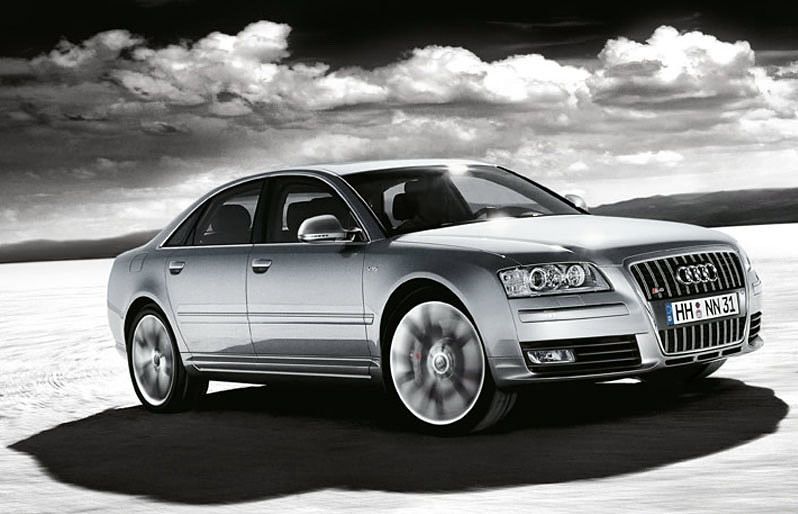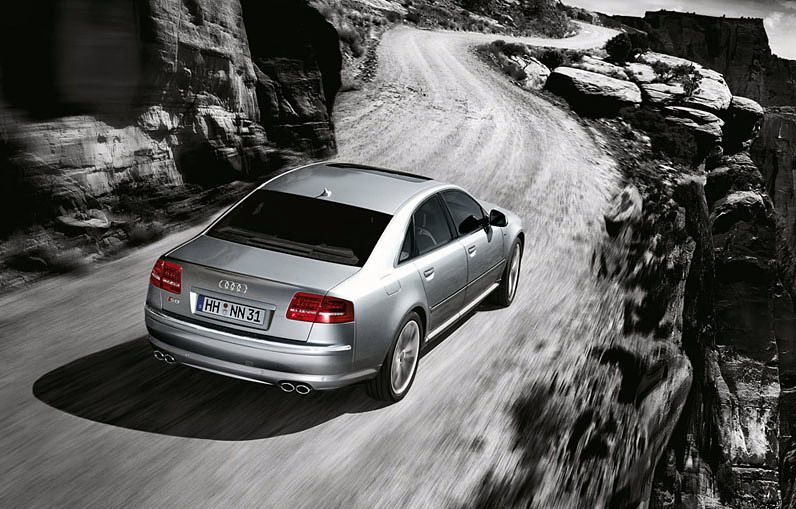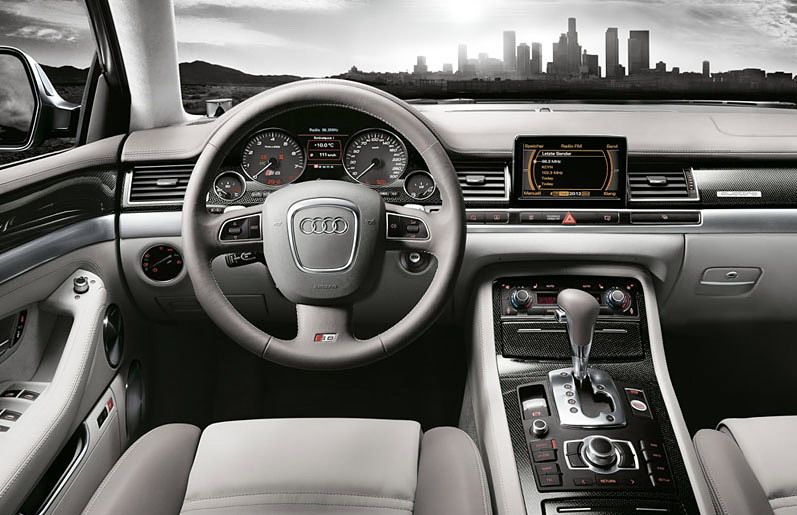The Audi S8 is the supreme athlete in the luxury class: With its combination of ten-cylinder FSI power, permanent – and here particularly sporty – quattro four-wheel drive and Audi Space Frame, the Audi S8 occupies a unique position within its competitive field of high-performance saloons. The outstanding potential of the ten-cylinder powerpack finds its counterpart in the dynamically tuned sports suspension, high-performance brake system and sporty yet elegant design.
2008 Audi S8
- Make: Array
- Model: 2008 Audi S8
2008 Mercedes C 63 AMG Estate
- Make: Array
- Model: 2008 Mercedes C 63 AMG Estate
- Engine/Motor: four-stroke, single cylinder, DOHC, 4-valve, liquid-cooled
- Horsepower: 48 hp (35 KW) @ 9,000 rpm
- Torque: 41 Nm @ 7,500 rpm
- Transmission: 5-speed gearbox with #520 chain final drive
- [do not use] Vehicle Model: Array
Sports appeal is firmly anchored in the genetic code of the Audi brand. In the case of the S models, however, sportiness is a declared principle, combined with comfort, aesthetics, elegance and uncompromising quality. The Audi S8 with its 5.2-litre V10 FSI engine combines all of these strengths to produce passion and superiority. The V10 of undersquare configuration utilises the expertise of the Lamborghini Gallardo super sports car, but has been reengineered in essential areas.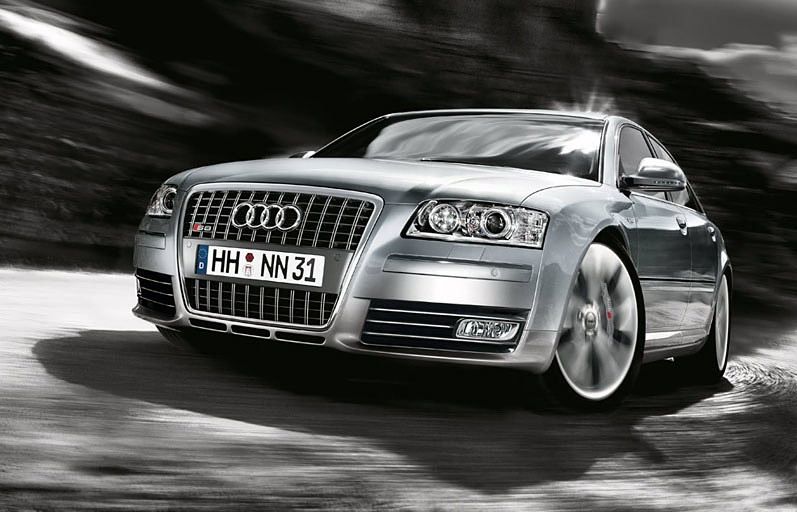 A ten-cylinder engine is the ideal design for realising sporting aspirations. Although an eight-cylinder engine would be even more compact, to make it into the five-litre class it would need large, heavy pistons and connecting rods, so its ability to rev freely would be impaired as a result. It is no coincidence that competitors have generally concentrated simply on high torque with their large-capacity V8 engines, rather than attempting to squeeze sporty performance out of them too.
A ten-cylinder engine is the ideal design for realising sporting aspirations. Although an eight-cylinder engine would be even more compact, to make it into the five-litre class it would need large, heavy pistons and connecting rods, so its ability to rev freely would be impaired as a result. It is no coincidence that competitors have generally concentrated simply on high torque with their large-capacity V8 engines, rather than attempting to squeeze sporty performance out of them too.
Spontaneous response
The other advantages of the high-speed V10 design are quite clear: the engine fascinates with its spontaneous response and short reaction times. It produces a throaty sound when accelerating and yet has a beefy torque curve even at low speeds. All in all it forms the perfect synthesis of sporty driving enjoyment and comfort on long journeys.
The 331 kW / 450 bhp V10 in the Audi S8 also belongs to the new generation of V engines from Audi, all of which feature a standard 90-degree included angle and a spacing of 90 millimetres between cylinder centres. The crankcase of the Audi ten-cylinder powerpack is made from a hyper-eutectic aluminium alloy. This technology renders separate cylinder liners superfluous; the liners are instead honed directly from the material by exposing the hard silicon crystals. The connecting rods are made from forged steel, and the pistons from an aluminium alloy. At the rated engine speed, each of them covers an average of 21.7 metres per second.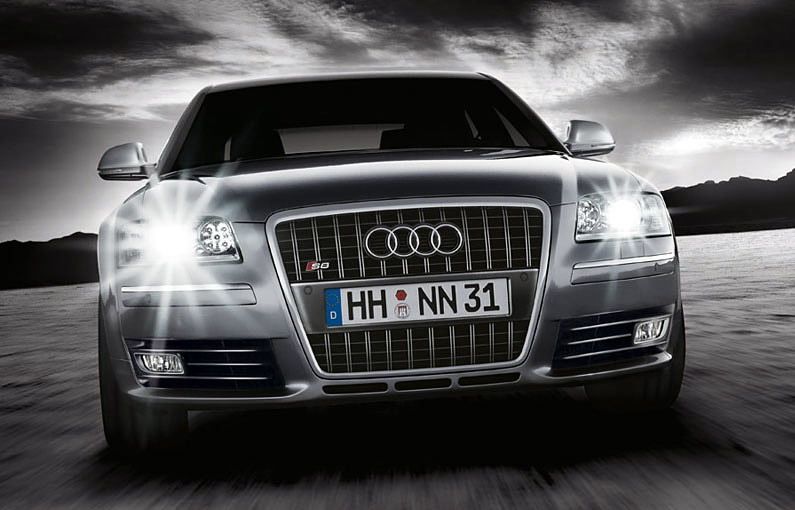
Performance and pulling power
The V10 in the Audi S8 uses FSI petrol direct injection. This has impressively demonstrated its dynamic potential in motor sport – the R8 racing car featuring this technology represented Audi five times at the 24-hour Le Mans race and captured four victories. The common rail injection system delivers the fuel directly to the combustion chambers in precisely metered amounts, at a pressure of up to 100 bar.
The powerful ten-cylinder engine has been optimised for high torque as well as high engine power. From as low as 3,000 to 4,000 rpm it delivers 540 Nm to the crankshaft. More than 90 per cent of the torque is available at 2,300 rpm. The V10 imparts the luxury saloon with the road performance of a high-calibre sports car. The Audi S8 sprints from a standstill to 100 km/h in 5.1 seconds. Only a short while later it reaches its governed top speed of 250 km/h, also facilitated by its low drag coefficient.
The engine is content with 13.4 litres of Super Plus fuel per 100 kilometres – this is also thanks to its consistent lightweight design concept, which clearly sets apart the A8 model range from its competitors. With its innovative aluminium body, the Audi Space Frame ASF, the S8 weighs a mere 1,940 kilograms, including the dynamic and sure-footed new-generation quattro drive, which boasts asymmetric/dynamic torque distribution.
Running gear underlines dynamic character
The centre differential distributes 40 per cent of the torque to the front and 60 per cent to the rear – this slightly rear-biased split underlines the dynamic character of the Audi S8. The new S8 is equipped with a six-speed tiptronic transmission as standard. In keeping with the character of this sporty top-of-the-line model, the final ratio of the automatic transmission is lower than on the A8 – the saloon is still capable of forceful acceleration even in sixth gear.
With regard to the running gear, the S8 relies on adaptive air suspension sport, the optional sports suspension for the A8. On the S8, however, the characteristics of the air springs and the shock absorbers integrated into the air spring bellows are somewhat firmer. With a further reduction in rolling and pitching movements, the sporty top model behaves with even greater agility and manoeuvrability, but is as stable and safe as ever. The elastokinematics of the rubber mounts in the axles have likewise been modified in keeping with the character of the S8.
The Audi S8 leaves the factory with newly developed cast aluminium wheels with a parallel-spoke S design. Their dimension is 9 J x 20, the wide tyres are size 265/35 R20. An 18-inch brake system assures a superlative braking performance. It features four large-size ventilated brake discs.
Ceramic brakes with tremendous potential
The optional ceramic brakes, which are also available for the twelve-cylinder A8, are a special feature for the S8. The impressive diameters of the ceramic brake discs – 380 mm at the front and 356 mm at the rear – are an immediate indication of their tremendous potential. The discs are made from a composite material comprising high-strength carbon fibres embedded in hard, frictionally resistant silicon carbide, a material that has already proven itself in the aerospace industry. The discs are bolted to a stainless steel chamber via resilient connecting elements.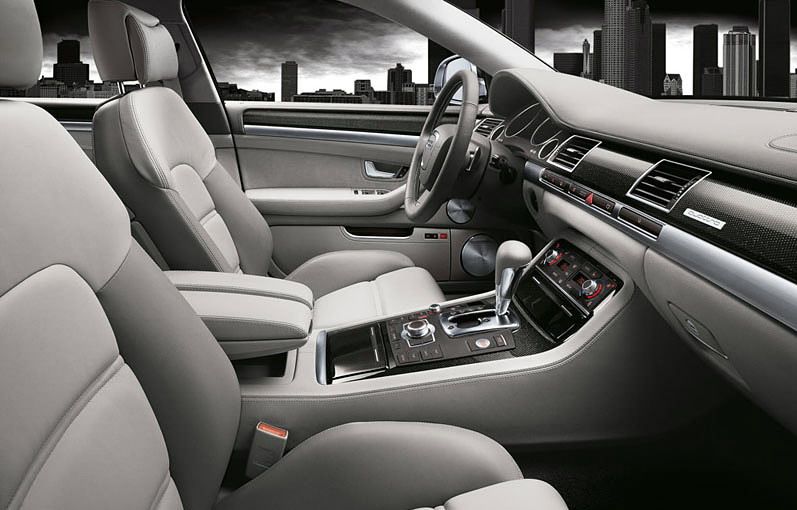 The ceramic discs offer significant advantages compared with conventional steel discs. They offer a high braking performance, especially at the limit, and are largely unsusceptible to heat fading – a major safety bonus for a sporty high-performance car such as the Audi S8. The high-tech material is completely resistant to corrosion. Ceramic discs will last for up to 300,000 kilometres, four times as long as steel discs. And not only that, at around five kilograms per unit, they weigh half as much as their steel counterparts – this reduction in unsprung masses improves both handling and ride comfort.
The ceramic discs offer significant advantages compared with conventional steel discs. They offer a high braking performance, especially at the limit, and are largely unsusceptible to heat fading – a major safety bonus for a sporty high-performance car such as the Audi S8. The high-tech material is completely resistant to corrosion. Ceramic discs will last for up to 300,000 kilometres, four times as long as steel discs. And not only that, at around five kilograms per unit, they weigh half as much as their steel counterparts – this reduction in unsprung masses improves both handling and ride comfort.
Optically, the high-tech brake system can be identified by the special cooling ducts and the perforation of the discs as well as by anthracite-coloured callipers with the "Audi ceramic" logo. A six-piston aluminium monobloc calliper is used at the front wheels, a nodular cast iron floating calliper at the rear. The dynamic stability system ESP is specially tuned for interaction with the ceramic brake system.
The Audi S models have always epitomised high performance and refined sports appeal. The same applies to the S8 – it lends the design of the A8 a dynamic edge. This prestigious saloon is already inherently light and elegant in character – its aesthetic appeal reflects its exceptional position as a sports model in the luxury class. The S8 cuts a supremely athletic figure, but never looks aggressive. The most striking changes are to be found at its front end. The eye-catching single-frame grille bearing the S8 badge is in platinum grey, and its double vertical struts have a chrome-look finish.
An ambience of luxurious sportiness
Besides the 20-inch wheels with the new S design and the special brakes, four details on the side sections indicate the potential of the V10 engine: badges on the wings and the front brake callipers, door handles with aluminium trim strips and aluminium-look exterior mirror housings. At the rear, the S8 badge, an integrated rear spoiler, a subtle light-refracting edge in the apron and an exhaust system with four oval tailpipes complete the range of optical modifications.
The S8 also adds various specific accents to the luxurious interior. The S8 sports seats, which have a wide range of adjustment features, have two-colour upholstery with stitching in a contrasting colour. The colour combinations underscore the ambience of luxurious sportiness. Further details of the interior distinguish the sporty top model from the A8. The highly-polished door sill trims bear S8 badges, the inlays on the door and centre console are made of brushed aluminium or carbon fibre. The three-spoke multifunction steering wheel features colour-contrasting stitching and aluminium-look paddles as well as an S8 badge.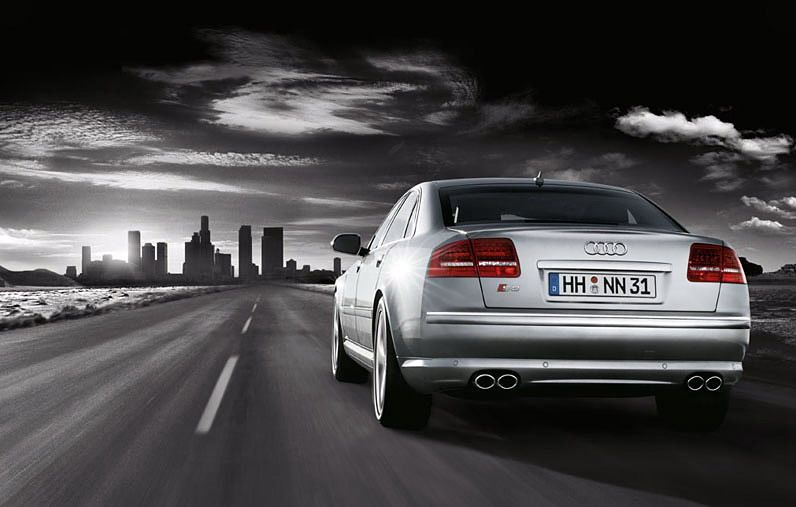 The innovative lighting technology known as adaptive light, including LED daytime running lights, is standard equipment on every Audi S8. Here the xenon plus headlights are coupled with static turning light and dynamic cornering light as well as separate LED daytime running lights – as on the A8 W12. As well as adaptive light technology, 20-inch wheels and an 18-inch brake system, the standard specification incorporates other comfort and convenience equipment items. These include new, noise-insulating double glazing for the windows, a DVD navigation system and Bose Surround audio system with CD changer. The door armrests and the centre console in the S8 are upholstered in leather, together with the seats.
The innovative lighting technology known as adaptive light, including LED daytime running lights, is standard equipment on every Audi S8. Here the xenon plus headlights are coupled with static turning light and dynamic cornering light as well as separate LED daytime running lights – as on the A8 W12. As well as adaptive light technology, 20-inch wheels and an 18-inch brake system, the standard specification incorporates other comfort and convenience equipment items. These include new, noise-insulating double glazing for the windows, a DVD navigation system and Bose Surround audio system with CD changer. The door armrests and the centre console in the S8 are upholstered in leather, together with the seats.
The standard access and authorisation system known as advanced key permits the driver to open the S8 without having to take hold of the key. The driver can then switch on the ten-cylinder powerplant by pressing the Start button and immediately enjoy its inimitable sound.

